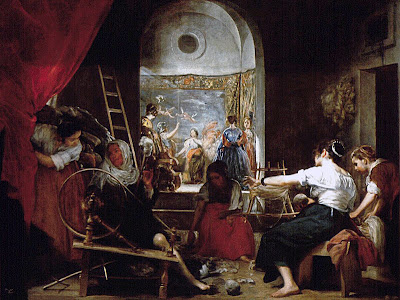 The Lady of Shalott by Burne-Jones
The Lady of Shalott by Burne-Jones"We think of our lives - and of stories - as spun threads, extended and knitted or interwoven with others into the fabric of communities, or history, or texts. An intriguing exhibition at Compton Verney in Warwickshire, The Fabric of Myth, mixes ancient and modern - Penelope's shroud, unpicked nightly, with enterprising tapestries made in a maximum security prison out of unravelled socks. In an essay in the accompanying catalogue, Kathryn Sullivan Kruger collects words that connect weaving with storytelling: text, texture and textile, the fabric of society, words for disintegration - fraying, frazzling, unravelling, woolgathering, loose ends. A storyteller or a listener can lose the thread. The word "clue", Kruger tells us, derives from the Anglo-Saxon cliwen, meaning ball of yarn. The processes of cloth-making are knitted and knotted into our brains, though our houses no longer have spindles or looms.
The Greeks had the Moirae, the Fates, one to spin the yarn, one to draw out the thread, one to cut it. They are sometimes confused with the Graiae, three grey old women with one eye and one tooth between them, sisters of the Gorgons. There is a beautiful and surprising tapestry from a Henry Moore drawing in this exhibition, depicting the three Fates, Clotho, Lachesis and Atropos, as grave swathed figures, with Atropos standing between her sisters, pointing the fatal shears at the life-thread moving between the two. Their faces are solemn and sad, the first two apprehensive, Atropos almost appalled. Milton confused her with the Furies, in "Lycidas", when he wrote: "Comes the blind Fury with th' abhorred shears, / And slits the thin-spun life." This is unforgettable partly because of the way those thin-sounding words - "slits", "thin-spun", "life" - mimic the dangerously fine thread.
The Norse, too, had their three Fates - the Norns, who spun the thread of life at the roots of the World Ash, Yggdrasil. They are sometimes young, mature, old, and sometimes three crones. They sing wildly in Wagner's Götterdämmerung, as the plot of the world unravels. Their thread is a golden rope that was once attached to the destroyed World Ash and is now precariously anchored on other trees and sharp rocks. It rips apart; they wind themselves in it, and go under the earth; the Twilight of the Gods has come."
 Velazquez - Las Hilanderas 1644-1646
Velazquez - Las Hilanderas 1644-1646Taken from Wikipedia;.....
The spinning wheel, introduced into from India between the 13th and 14th centuries, improved the hand-spinning method. The spindle was set horizontally in a wheel turned by a foot pedal and produced a single thread. Spinning by hand is still the principal method used in many developing countries."The spinning wheel replaced the earlier method of hand spinning with a spindle The first stage in mechanizing the process was mounting the spindle horizontally so it could be rotated by a cord encircling a large, hand-driven wheel. The great wheel is an example of this type, where the fiber is held in the left hand and the wheel slowly turned with the right. Holding the fiber at a slight angle to the spindle produced the necessary twist The spun yarn was then wound onto the spindle by moving it so as to form a right angle with the spindle. This type of wheel, while known in Europe by the 14th century, was not in general use until later. It ultimately was used there to spin a variety of yarns until the beginning of the 19th century and the mechanization of spinning.
No comments:
Post a Comment
Love having comments!